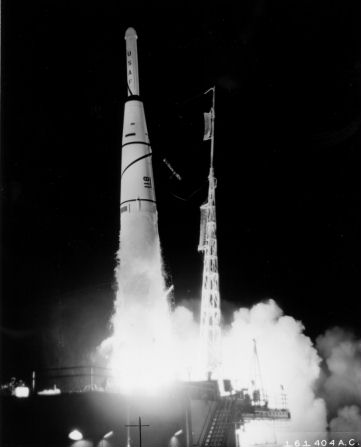THOR-ABLE 0 FACT SHEET
By Cliff Lethbridge

Thor-Able 0 Launch, Photo Courtesy U.S. Air Force
Classification: Research Rocket/Space Launch Vehicle
Length: 90 feet
Diameter: 8 feet
Date of First Cape Canaveral Launch: April 23, 1958
Date of Final Cape Canaveral Launch: July 23, 1958
Number of Cape Canaveral Launches: 3
Using the Thor IRBM as a core booster, the Thor-Able 0 rocket was introduced in 1958. The vehicle was originally designed to support high-altitude U.S. Air Force and civilian re-entry vehicle research. The Thor-Able 0 was later modified to carry small satellites into orbit, and became the first Thor-based variant to do so. Thor-Able 0 was the first generation of what would become the Delta family of space launch vehicles which remain in use today. The Thor-Able 0 employed a Rocketdyne first stage engine which burned liquid oxygen/RP-1 (kerosene) liquid fuel and could produce 150,000 pounds of thrust at launch. The second and third stages were adapted directly from the Vanguard rocket. An Aerojet second stage engine burned IRFNA/UDMH solid fuel and could produce a 7,575-pound thrust. An Altair solid-fueled third stage engine could produce a thrust of 2,760 pounds.
The first three Thor-Able 0 rockets were launched from Cape Canaveral in support of the Atlas missile research and development program. These Thor-Able 0 rockets were powerful enough to duplicate the intended Atlas full-range flight distance of 6,000 miles. For this reason, Thor-Able 0 rockets were selected to produce high speed re-entry data of the ablative-type heat resistant material proposed for Atlas missile nosecones. But in addition to supporting the tests of vital Atlas missile hardware, these Thor-Able 0 flights also carried out some groundbreaking biological research. Each of the three nose cones launched in this test series carried a lone mouse as passenger. Electronic monitoring of these mice would determine whether or not animals could survive a long-range missile flight. These tests would prove to be significant since the mice would reach maximum altitudes of 600 to 1,000 miles above Earth during their journey, and experience long periods of weightlessness and gravity stress.
These Thor-Able 0 flights did provide useful data on ablative nose cone technology, but the mice did not fare so well. The first of these Thor-Able 0 rockets carried a mouse named “Mouse-In-Able-1” (MIA-1), nicknamed “Minnie Mouse” and was launched on April 23, 1958. The rocket exploded due to a first stage gearbox failure. The second of these Thor-Able 0 rockets carried a mouse named “Mouse-In-Able-2” (MIA-2) and was launched on July 9, 1958. The mouse survived its entire flight, but recovery crews were not able to locate the nose cone. The last Thor-Able mouse, named “Wickie Mouse” in honor of the nickname of Cape Canaveral journalist Mercer “Wickie” Livermore, was launched on July 23, 1958. This mouse also survived its flight, but recovery crews were not able to locate the nose cone. Even though the nosecones were not recovered in the two successful Thor-Able 0 research flights, the fact that flights of 6,000 miles were achieved prompted Douglas Aircraft to propose an ICBM version of the Thor called Thor-Intercontinental, or “Thoric”. Proposals for a Thoric missile were quickly rejected by the U.S. Air Force, however, since development of the Atlas and Titan ICBM weapons systems were already well underway. Thor-Able 0 research rockets were, however, modified to carry out satellite launching missions. Each Thor-Able 0 was capable of carrying a maximum 300-pound payload into low-Earth orbit.


